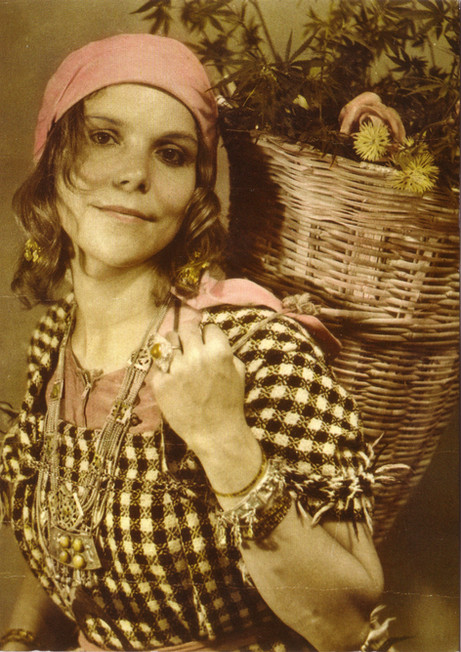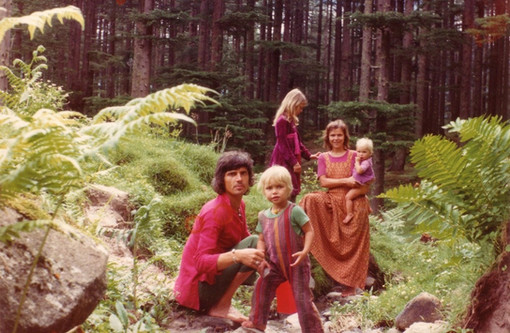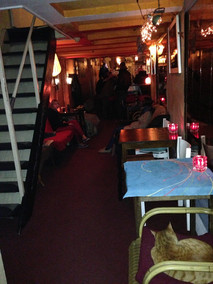HAIL TO THE QUEEN
- Bobby Black
- Jul 9, 2022
- 11 min read
Updated: Nov 18, 2022
Dutch entrepreneur, inventor, and adventurer Mila Jansen has been smoking, smuggling, and making hashish for over half a century. Along the way, she’s revolutionized how it's made, established herself as an international cannabis icon, and more than earned the title by which she’s known—the Hash Queen.

EARLY LIFE
Mila Jansen was born in Liverpool, England on Dec 5, 1944, during the heat of the Second World War. Though both of her parents were Dutch, they’d fallen in love in the US, and it was on their way home to Holland that little Mila entered the picture. International travel, it seems, would become embedded into her soul from an early age: the daughter of a Shell Oil executive, she was forced to relocate back and forth between England, Indonesia, and the Netherlands numerous times during her childhood before settling more permanently in Amsterdam in 1955. As a young woman, she found work in greenhouses, allowing her to indulge her love of plants. At the age of 18, Mila got pregnant and dropped out of high school. She gave birth to her first daughter Miloes in 1964. The following year, she tried hashish for the first time—thanks to her boyfriend at the time who was studying medicine.
“He wanted to see the effect of someone who was smoking hash,” Jansen says. “In those days you couldn't get weed in Amsterdam—only hash. You went down to the harbor, where it would be brought in by sailors from Turkey, Iran, Pakistan, and Africa. You bought it by the matchbox-full. I rolled my first joint (tobacco and hash) and I remember a short time later I was just lying on the floor rolling with laughter. It was love at first toke.”
"I rolled my first joint (tobacco and hash) and I remember a short time later I was just lying on the floor rolling with laughter. It was love at first toke.”

KINK 22
In 1965, Mila rented a room near the center of town and got a job as a seamstress for a local fashion studio, where she befriended a gay designer named Henk Koster. In spring 1966, the duo leased a storefront at 22 Tweede Rozendwarsstraat and opened their own clothing boutique, which they called Kink 22.
“We couldn’t think of a name because we only had two and a half weeks to set it up," she recalls. “Then The Kinks had a number one hit that week, and our house number was 22, so it became Kink 22.”
Employing custom designers, they began churning out mod and hippie style clothing—becoming the first shop in Holland to sell miniskirts. Almost immediately, the boutique became the hippest spot in town. At the height of the counterculture revolution, Kink 22 attracted creative spirits from all over the world— including Tina Turner, who once bought a dress there. And in 1967, Dutch filmmaker Erik Terpstra even shot a portion of his art film De Verloedering van de Swieps (a.k.a. The Whipping Cream Hero) at the shop (in which Mila played a role).
“It was the '60s, so it was an amazing period with lots of wild parties.”
But the boutique became so popular that they soon had trouble keeping up with demand.
“It was actually quite hard work. We had three guys stitching dresses all week, then on Saturday, we’d sell out,” Mila explains. “So after one and a half years, that got a bit exhausting, and seeing as my friends felt there was no good place to hang out during the day, we changed the boutique into a tea shop.”

In November 1967, Mila and Henk changed the name of the shop from Kink 22 to Cleo de Merode (named after a French ballet dancer considered to be the most beautiful woman in the world), stopped selling clothes, and began selling tea. Due to the fact that a cup of tea there often came served with a free joint (again, containing tobacco and hashish, as there still wasn’t any cannabis there yet at that time), their teahouse is considered by many to be the prime precursor of the cannabis coffeeshops that would later come to dominate the city.
“We might have been the first coffeeshop, apart from the fact that we never sold anything,” Mila chuckles. “We just traded and shared whatever hash might arrive from Turkey, Lebanon, or Afghanistan.”

Their hip hangout attracted all kinds of people from around the world who came to drink tea, have a smoke, and trade goods. Among the patrons who’d frequent the shop were veterans and deserters from the war in Vietnam, as well as visitors from the Far East, who regaled them with tales of exotic lands and killer hash. Unfortunately, the teahouse became so popular that neighbors started complaining about the noise and indecent behavior of her patrons. Within a year, the police shut Cleo de Merode down—and worse, threatened to have social services take her daughter Miloes (now three years old) away from her. She decided it was time to go.
“I was on my way to travel to Mexico when this guy walked into the teahouse who’d been to India, talked about the Tibetans and Saddis, and within two hours my whole plan changed. No more Mexico—I was heading for India!”
So in 1968, with only $600 in her pocket, Mila and her daughter set out for India.

PASSAGE TO INDIA
Under scrutiny from police and child protective services due to the drug activity at her tea house, and feeling a need to break from western civilization in general, Mila decided to flee with her daughter to India in search of freedom, peace of mind, of course, great hashish.
“Everything was about controls in the West,” she observes. “I didn’t like that.”
Mila’s six-month-long journey to India—first by van and bus, then by hitchhiking— took her through much of Europe, then on into the Middle East. There, locals marveled at her blonde-haired, blue-eyed daughter, as many had never seen someone who looked like that. Along the way, she spent nearly a month in Mazar-I-Sharif making dry sift with the locals, smoked a hookah with cops at the Iranian/Afghan border, and rode in the back of a truck atop boxes of dynamite.
“We’re sitting there smoking some biddies, and my daughter, who was just learning to read, said, "What does that mean? Die..no..mite?” And it turned out, the truck was carrying boxes of dynamite! (Laughs). We banged on the back door for the driver and yelled, ‘Stop! Stop!’ We jumped out even before the truck stopped.”
She finally arrived in India in December 1968—just in time for her 24th birthday. Mila loved India so much that she spent the next 14 years living there with barely any possessions—summering in Manali and wintering in Goa (a popular destination for hash-loving foreigners).
During her time in India, Mila made a living by mailing items back to Holland to sell, including Tibetan jewelry, dresses from Delhi, and blocks of hash hidden in hollowed-out books. She also ventured to Nepal, where she traveled with nomads, learned to make charas (by rubbing fresh buds between one’s hands), visited Tibetan monasteries, and even took robes as a Buddhist nun for a time.

“By the time I reached Kathmandu, I realized that wherever me and my daughter are, that’s where home is.”
In 1971, during a visit back home to Amsterdam, she fell in love with a fellow Netherlander named Hans Swart, who married her and fathered her next two children. Though Mila had many adventures hiking through the Himalayas—some of which included meeting the Dalai Lama and being attacked by wolves—only one was documented on film: a three-month-long odyssey with Hans, their kids, a local guide named Shanti in 1976 that they hoped to turn into a documentary one day. Unfortunately, the documentary never materialized, and that footage ended up collecting dust in a suitcase for decades.
RETURN TO HOLLAND
In 1988, Mila took her youngest son Chimed and returned to Amsterdam for good, where her daughter Miloes was living with her boyfriend (her two other children stayed at their boarding school in India). As a single mom with four kids to support and no professional resume, she turned to her old passion for gardening to earn a living. Unlike when she’d left around 14 earlier, Amsterdam was now filled with cannabis—thanks to the city’s bustling coffeeshops, which were all in need of constant restocking. And so before long, she threw her hat into the male-dominated field of illicit cannabis cultivation.
“I started off by making clones, and a year later I started my own eighteen-lamp garden. It went well and I could pay all the school bills.”
Within a few years, she was running 13 gardens all across the city. But in 1992, her largest grow— a greenhouse with 24,000 plants—was raided by police just ten days before harvest. Other busts followed, forcing her to reassess her career.
"I suddenly realized, 'What the hell are you doing? You got four kids sitting at home.' So I stopped.”
Fortunately, though, a new opportunity was about to present itself—one that would establish her as the new hash queen of Amsterdam.
THE POLLINATOR
It wasn’t until her return to Amsterdam from India that Mila had actually tried smoking cannabis flower, and she didn’t really care for it…nor did she particularly care for much for the hash that was available in coffeeshops at the time. As a result, she’d gotten into the habit of making her own hash to smoke, which she did the old-fashioned way by dry-sifting the leftovers from her various grows—a slow, tedious process best done in the cold. She continued doing that for a couple of years…until one night in 1994 when, while doing some laundry, she had an epiphany.
“I was standing in front of my washing machine with its clothes dryer on top of it, and it suddenly hit me: what those clothes were doing inside the dryer, waffling around like that, is exactly what I was going with this dried [plant] material. So the next morning I went over to my work and told the guys, we’ve got to get an old clothes dryer. And we did, we put a screen around the drum, took away the heating, and we threw our leaves in, and lo and behold the crystals were lying in the bottom of the clothes dryer. Well, we used that clothes dryer for three years. I had invented the Pollinator.”
Simple yet brilliant, the Pollinator was the first device ever designed to separate the trichomes from dried cannabis mechanically rather than by hand (how it had been done for thousands of years prior).
“I had 5000 guilders (Dutch dollars) left after all those years of growing, so I used them to build the first three Pollinators,” she says.

As it turns out, that November was the first time that High Times opened up their Cannabis Cup event to the public—drawing a huge crowd of pot enthusiasts from around the world to their expo in Amsterdam—the perfect venue to showcase her revolutionary new invention.
“Robert Connell Clarke unveiled it at the High Times Cannabis Cup that year, and it’s taken off from there. We still sell the same machines…the shape has changed a bit, but it’s the same system."
The invention of the Pollinator led to the creation of what’s known as “nederhash”— a style of dry pressed hash made in the Netherlands. (Before this, almost all hash in Amsterdam was imported.)
With their catchy slogan of “Hash from Trash,” Mila and her team started selling the machines like hotcakes (or should I say, pannekoeken). The Pollinator was soon followed by her Ice-O-Lator bags in 1998, and the Bubbleator in 2005 (both of which are used for ice water extraction to make “bubble hash”). The success of her extraction machines earned Mila not only a handsome living, but also a regal new honorific: the Hash Queen.
(Side note: As a way to prove copyright/ownership of her new Pollinator hash bag invention should the need ever arise, Mila mailed the prototype bags to herself and never opened the package. We at World of Cannabis are extremely proud to say that this one-of-a-kind artifact is now in our collection—donated to us by Mila herself.)
In 1997, Mila opened a big Pollinator shop at Nieuwe Herengracht 25 in Waterlooplein—just around the corner from the Amstel River—which became her second home, and a haven for cannabis-loving travelers from around the world. Unfortunately, in 2015, the Dutch government informed Mila that her shop was considered the equivalent of an illegal grow shop (similar to the way the US government considered grow shops illegal during Operation Green Merchant in the 1980s). As a result, Mila’s employees of 14 years were forced to quit, and she was forced to go to court. Thankfully, she later won her case, but not before she made the difficult decision to sell the shop—this way, she could at least make some money from the sale, as opposed to losing everything if authorities shut it down. Today, her Pollinator company operates out of a warehouse north of the city.
HEMP HOTEL
Riding high on the heels of her success with the Pollinator, Mila invested some of her newly acquired capital into another marijuana-related venture: the Hemp Hotel. Leasing a small building on Frederiksplein (just a few blocks from the Heineken Brewery), Mila and her second daughter Elferra opened the small budget hotel dedicated to hemp education in 1998. The Hemp Hotel featured five rooms, each decorated to reflect a different exotic region they’d visited (Caribbean, Afghani, Indian, Tibetan, and Moroccan). They also incorporated hemp into many of the hotel’s amenities—including soaps, shampoos, curtains, and mattresses. Their onsite bar/café even served 11 kinds of hemp beer and hemp rolls with breakfast. And once a month, their “Hemple Temple Nightbar” hosted a “Ladies' Hash Night” gathering. Sadly, in 2013, their landlord chose not to renew their lease and the Hemp Hotel was permanently closed.

MILA’S JOURNEY
In 2007, her former husband Hans—who, sadly, was now dying of cancer—shared with her for the first time the reels of 8mm film he’d shot during their trip in India over 30 years earlier. After his passing, as a tribute to him, Mila decided to recreate a portion of their original Himalayan trek, film it, then combine that film with Hans’ old footage into a new documentary. The result was Mila’s Journey (2011)—a retrospective of Mila’s life and adventures, and a touching tribute to Hans which her sister helped produce. In it, she defies her doctor’s orders and the risk of a possible stroke or heart attack to return to the mountains—reconnecting with their original Tibetan guide Shanti and other locals she once knew while retracing the steps of a journey that forever changed her life.
DAB-A-DOO
In the early 2010s, butane hash oil (BHO) and “dabbing” became all the rage in America—far eclipsing traditional hash, which hadn’t been popular in the States in decades. While some old-schoolers resisted the new, more potent and technological form of extracts, Mila—to her credit—embraced them. After attending the Chalice hash festival in California and serving as one of its celebrity judges, Mila was inspired to organize her own concentrate competition.
On her 69th birthday, during the 2013 Cannabis Cup in Amsterdam, the Hash Queen hosted a big party at her Pollinator shop which she dubbed Dab-a-Doo—an invitation-only event focused on dabbable concentrates. Though originally meant to be a one-time event, it was so popular that three months later, she hosted one during Spannabis in Barcelona, followed a few months later by another during the US Cannabis Cup in Denver. To date, she’s now hosted 30 Dab-A-Doos in various locations all around the globe, including Miami, Mexico, Columbia, Costa Rica, Peru, and Jamaica.

AWARDS & ACCOLADES
Time has not slowed down this beloved marijuana matriarch. In 2017, she launched her own line of live resin called Hash Queen Extracts. The following year, she released her autobiography, Mila: How I Became The Hash Queen. And this fall, she’s doing another Dab-A-Doo tour through South America.
Over the past decade or so, Mila has been showered with accolades from every corner of the cannabis world. She’s received lifetime achievement awards from High Times, Chalice, and the Cannabis Business Awards.

In 2018, she was named one of High Times top 100 most influential people in cannabis, and on April 20, 2020, World of Cannabis (in association with the CBAs) named her a 420 Icon—that is, one of the 100 most significant figures in cannabis history. Yet, there’s one honor we still owe this lovable living legend: an official coronation. Because after all, every queen must surely have a crown.
Follow Mila on Instagram at @milahashqueen
























































